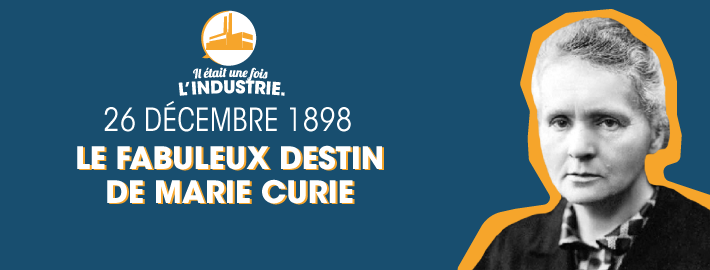GLOBAL
INDUSTRIE
News
Share on

26 December 1898: the fabulous destiny of Marie Curie
123 years ago, Pierre and Marie Curie announced the discovery of radium and polonium to the Academy of Sciences and at the same time proposed the word “radioactivity” to describe the fruit of their research. We look back on an event which was to change the face of the world.
THE EXTRAORDINARY STORY OF AN EXCEPTIONAL WOMAN
It all began with a talented French physicist, Henri Becquerel. This researcher, a professor at the Ecole Polytechnique and member of the Academy of Sciences, was working on uranium salts and their radiation in 1896. When observing a photographic plate placed in contact with them, he noticed that a print appeared on it even if they were not subjected to sunlight. This meant that they emitted their own radiation, which he called "hyperphosphorescence". This theme fascinated a young doctoral student so much that she chose it as the subject of her thesis. Her name was Marie Curie…
The young woman’s story is exceptional to say the least. Marie Sklodowska was born on the 7th of November 1867 in Warsaw to a father who was a mathematics teacher and a mother who was a primary school teacher. She lost her sister and her mother very young and found refuge in study, excelling in every subject. The only obstacle, albeit a major one, was that higher education was barred to women in her native country. She therefore left for Paris in 1891 and enrolled in physics at the Paris Faculty of Sciences. To give you an idea of the young lady’s excellence, out of the 776 students at the faculty in January 1895, only 27 were women and 7 were foreigners. It was nevertheless there that she came first in her bachelor’s degree class in physics in July 1893 and second in her class the following year in mathematics. It was during this period that, through a common acquaintance, she met a certain Pierre Curie, who was head of physics work at the Municipal School of Industrial Physics and Chemistry. She worked with him and a more intimate relationship quickly formed between them. They married on the 26th of July 1895. A year later, she came first in the agrégation examination for mathematics and started work on her thesis …
A RADIANT DISCOVERY
She thus continued the work of Henri Becquerel, and it was at this time that she first observed that the intensity of radiation is proportional to the quantity of uranium present. She worked on several minerals which contained it, including pitchblende (from the German pechblende or "false pitch”), extracted from the silver mines of Bohemia, which has a stronger than normal radioactivity – a term she chose to replace the barbarous word "hyperphosphorescence". She then posited the hypothesis that in addition to uranium there was another component which explained this radiation and worked with her husband to isolate it. In July 1898, the couple thus announced that they had discovered polonium, a name given in honor of Marie’s homeland. On the 26th of December of the same year, they declared together before the Academy of Medicine that they had been able to isolate a second, even more radioactive element: radium.
This discovery of radioactivity enabled the couple to share the Nobel Prize for Physics with Henri Becquerel in 1903. Unfortunately, Pierre scarcely had time to benefit from his new-found fame: he died on the 19th of April 1906 after being struck by a horse-drawn vehicle. It was therefore alone that Marie obtained the Nobel Prize for Chemistry in 1911 for her work on polonium and radium. Having previously been the first woman to receive a Nobel Prize, she thus became, and still remains to this day, the only woman to have received two of them!
The application which was made of this discovery is surprising to say the least, retrospectively. At the beginning of the 20th century, radium was used in fact to treat certain diseases, particularly… cancer! It was also used during World War I to locate bullets in soldiers’ bodies. It thus took several decades for its danger to health to be noticed and it was not until 1937 that it was banned for non-medical uses. Marie Curie herself died on the 4th of July 1934 of leukemia, very probably caused by her exposure to radium. Her remains and those of her husband were transferred to the Panthéon on the 20th of April 1995 and her coffin was covered with a layer of lead to protect tourists from the radioactivity still emanating from her body…
2021.12.20